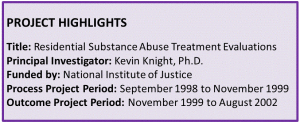Residential Substance Abuse Treatment Evaluations

According to a recent Bureau of Justice Statistics report, 5.4 million Americans nationwide were under correctional supervision in 1995, including about 1.6 million in prisons and jails. However, the majority of individuals were under supervision in community corrections (3.1 million on probation, 700,000 on parole). Texas had the largest number of probationers (400,000), surpassing California, Florida, and New York. Of these, most were felony (56%) or driving while intoxicated (felony or misdemeanor, 32%) offenders.
National data also indicates the majority of new arrestees have substance abuse problems. Data from the Arrestee Drug Abuse Monitoring (ADAM) program, formerly the Drug Use Forecasting (DUF) system, showed that about 68% tested positive for one or more illicit drugs at the time of their arrest in 1996. Accordingly, the criminal justice system is considered one of the most important gateways to the treatment delivery system. A study from the DATOS project showed clients who were under legal pressure remained in community-based long-term residential treatment longer, thereby improving posttreatment outcomes.
Many states are increasing resources for corrections-based treatment of criminal offenders with substance abuse problems. Similar programs were used in the 1970s, with the most visible being the Treatment Alternatives to Street Crime (TASC) program. In 1991, Texas adopted a major initiative (House Bill #2335) which authorized the development of a statewide network of community corrections-based residential substance abuse treatment facilities, or SATFs. This project helped establish an evaluation program (see TCU Correctional Forms) for one of the first SATFs in Texas, the Dallas County Judicial Treatment Center (DCJTC).
The DCJTC is an intermediate sanctions facility located in Wilmer (on the southern edge of Dallas). It provides 228 treatment beds (70% male, 30% female) for drug-involved felony probationers court-mandated to the program in lieu of incarceration. In addition to a 6-month primary care residential phase, the DCJTC also includes 2-to-3 month residential and 6-month outpatient aftercare components. Probationers receive substance abuse treatment, life skills training, relapse prevention, and educational and vocational training in a modified therapeutic community format. Evaluations conducted by the IBR showed that program graduates had lower rearrest rates than did program non-completers, both at 6 months and 1 year after treatment discharge.
RSAT Publications
Hiller, M. L., Knight, K., Leukefeld, C., & Simpson, D. D. (2002). Motivation as a predictor of therapeutic engagement in mandated residential substance abuse treatment. Criminal Justice and Behavior, 29(1), 56-75. [Abstract]
Hiller, M. L., Knight, K., Rao, S. R., & Simpson, D. D. (2002). Assessing and evaluating mandated correctional substance-abuse treatment. In C. G. Leukefeld, F. M. Tims, & D. Farabee (Eds.), Treatment of drug offenders: Policies and issues (pp. 41-56). New York: Springer.
Bartholomew, N. G., Hiller, M. L., Knight, K., Nucatola, D. C., & Simpson, D. D. (2000). Effectiveness of communication and relationship skills training for men in substance abuse treatment. Journal of Substance Abuse Treatment, 18(3), 217-225. [Abstract]
Hiller, M. L., Broome, K. M., Knight, K., & Simpson, D. D. (2000). Measuring self-efficacy among drug-involved probationers. Psychological Reports, 86, 529-538. [Abstract]
Hiller, M. L., Knight, K., & Simpson, D. D. (1999). Risk factors that predict dropout from corrections-based treatment for drug abuse. The Prison Journal, 79(4), 411-430. [Abstract]
Knight, K., & Hiller, M. L. (1997). Community-based substance abuse treatment for probationers: 1-year outcome evaluation of the Dallas County Judicial Treatment Center. Federal Probation,
61(2), 61-68. [Abstract]
Hiller, M. L., Knight, K., Devereux, J., & Hathcoat, M. (1996). Posttreatment outcomes for substance-abusing probationers mandated to residential treatment. Journal of Psychoactive Drugs, 28(3), 291-296. [Abstract]